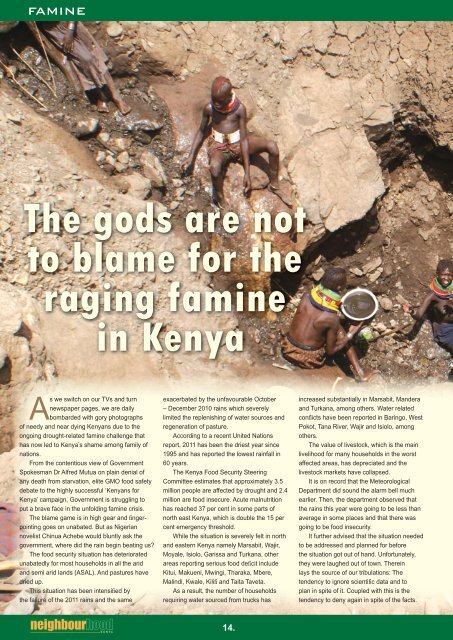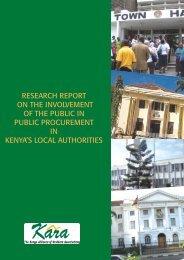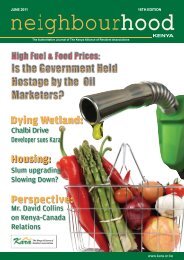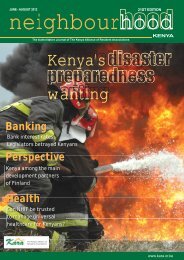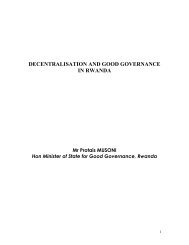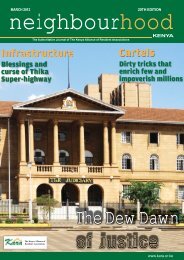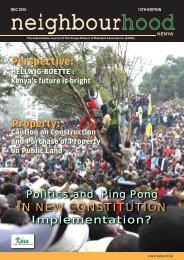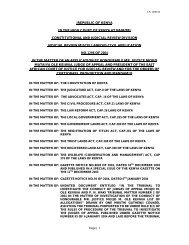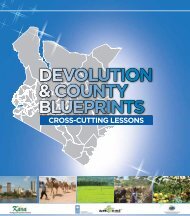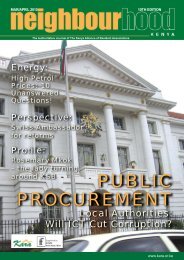KARA AUGUST 2011 ISSUE.indd
KARA AUGUST 2011 ISSUE.indd
KARA AUGUST 2011 ISSUE.indd
You also want an ePaper? Increase the reach of your titles
YUMPU automatically turns print PDFs into web optimized ePapers that Google loves.
FAMINE<br />
The gods are not<br />
to blame for the<br />
raging famine<br />
in Kenya<br />
As we switch on our TVs and turn<br />
newspaper pages, we are daily<br />
bombarded with gory photographs<br />
of needy and near dying Kenyans due to the<br />
ongoing drought-related famine challenge that<br />
has now led to Kenya’s shame among family of<br />
nations.<br />
From the contentious view of Government<br />
Spokesman Dr Alfred Mutua on plain denial of<br />
any death from starvation, elite GMO food safety<br />
debate to the highly successful ‘Kenyans for<br />
Kenya’ campaign, Government is struggling to<br />
put a brave face in the unfolding famine crisis.<br />
The blame game is in high gear and fingerpointing<br />
goes on unabated. But as Nigerian<br />
novelist Chinua Achebe would bluntly ask the<br />
government, where did the rain begin beating us?<br />
The food security situation has deteriorated<br />
unabatedly for most households in all the arid<br />
and semi arid lands (ASAL). And pastures have<br />
dried up.<br />
This situation has been intensified by<br />
the failure of the <strong>2011</strong> rains and the same<br />
exacerbated by the unfavourable October<br />
– December 2010 rains which severely<br />
limited the replenishing of water sources and<br />
regeneration of pasture.<br />
According to a recent United Nations<br />
report, <strong>2011</strong> has been the driest year since<br />
1995 and has reported the lowest rainfall in<br />
60 years.<br />
The Kenya Food Security Steering<br />
Committee estimates that approximately 3.5<br />
million people are affected by drought and 2.4<br />
million are food insecure. Acute malnutrition<br />
has reached 37 per cent in some parts of<br />
north east Kenya, which is double the 15 per<br />
cent emergency threshold.<br />
While the situation is severely felt in north<br />
and eastern Kenya namely Marsabit, Wajir,<br />
Moyale, Isiolo, Garissa and Turkana, other<br />
areas reporting serious food defi cit include<br />
Kitui, Makueni, Mwingi, Tharaka, Mbere,<br />
Malindi, Kwale, Kilifi and Taita Taveta.<br />
As a result, the number of households<br />
requiring water sourced from trucks has<br />
increased substantially in Marsabit, Mandera<br />
and Turkana, among others. Water related<br />
confl icts have been reported in Baringo, West<br />
Pokot, Tana River, Wajir and Isiolo, among<br />
others.<br />
The value of livestock, which is the main<br />
livelihood for many households in the worst<br />
affected areas, has depreciated and the<br />
livestock markets have collapsed.<br />
It is on record that the Meteorological<br />
Department did sound the alarm bell much<br />
earlier. Then, the department observed that<br />
the rains this year were going to be less than<br />
average in some places and that there was<br />
going to be food insecurity.<br />
It further advised that the situation needed<br />
to be addressed and planned for before<br />
the situation got out of hand. Unfortunately,<br />
they were laughed out of town. Therein<br />
lays the source of our tribulations: The<br />
tendency to ignore scientifi c data and to<br />
plan in spite of it. Coupled with this is the<br />
tendency to deny again in spite of the facts.<br />
14.


